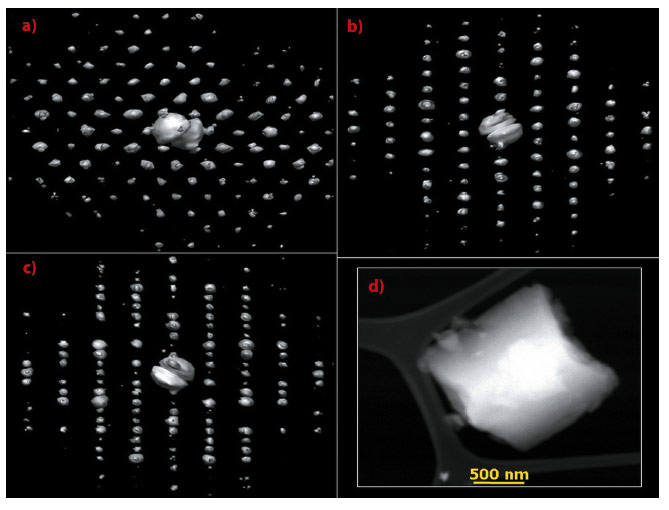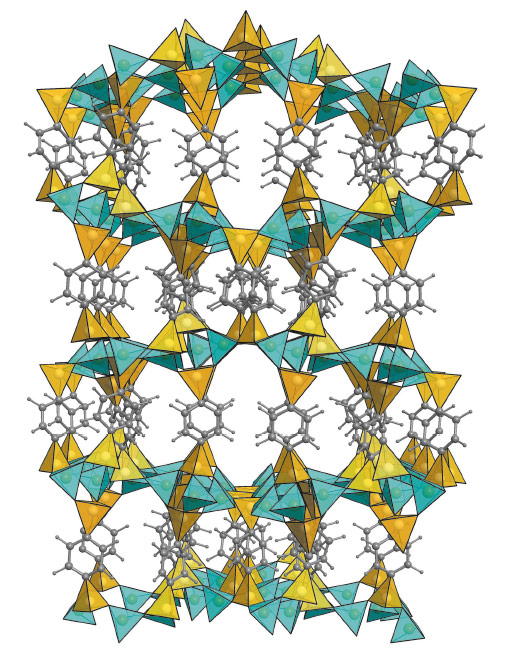- Home
- Users & Science
- Scientific Documentation
- ESRF Highlights
- ESRF Highlights 2012
- Structure of materials
- Towards hybrid organic-inorganic aluminosilicate zeolites
Towards hybrid organic-inorganic aluminosilicate zeolites
In recent years, X-ray powder diffraction has become a powerful tool for crystal structure determination. Significant advances over the last 10 years were made with the advent of new methods and algorithms, along with the availability of third generation synchrotron radiation sources. Nowadays, ab initio structure solution by powder diffraction data is almost a routine procedure. However, in the case of very complex structures and multiphase samples, it remains a challenging task. In order to overcome this problem, an approach based on the combined use of high-resolution X-ray powder diffraction and precession electron diffraction has been developed. Though very powerful, this approach cannot be applied to beam-sensitive samples. Therefore, a new technique called automated diffraction tomography (ADT) has recently been developed for the acquisition of electron diffraction data from submicrometric beam-sensitive crystals. Because of the very low electron dose striking the sample, ADT allows complete electron diffraction data collection, even on beam-sensitive materials.
ECS-3 is an interesting material belonging to the new family of crystalline hybrid organic-inorganic aluminosilicate referred to as eni carbon silicates. ECS-3 attracted our attention because of the N2 adsorption/desorption Type I isotherm, typical of microporous materials (specific surface area = 296 m2 g-1, specific pore volume = 0.13 cm3 g2). Unfortunately, the X-ray powder diffraction pattern of ECS-3, collected at the high-resolution beamline BM01 (0.80175(2) Å), showed extremely high complexity that prevented a correct unit cell determination. ECS-3 was then submitted to ADT data collection (Figure 133). Through symmetry information obtained by electron diffraction, the correct unit cell parameter as well as a possible space-group symmetry were derived. The search for the unit cell converged to a monoclinic symmetry with parameters: a =19.7, b = 27.7, c = 9.5 Å, β = 102.7° and possible space-groups C2/c or Cc. Using the ADT data and the non centrosymmetric space group, a preliminary structural model for the ECS-3 scaffolding was achieved by direct methods and completed by model building. The ECS-3 scaffolding involves 62 crystallographically-independent non-hydrogen atoms in the asymmetric unit, making it intriguing as the most complex zeolite structures.
 |
|
Fig. 133: a), b), and c) three-dimensional ADT diffraction volume reconstruction. d) ECS-3 crystallite used for the ADT data collection. |
The ECS-3 scaffolding structure can be described by the stacking of aluminosilicate layers held together by phenylene groups (Figure 134). This structural model confirms that ECS-3 is a microporous organic-inorganic alluminosilicate. Its microporosity results from the union of the organic and inorganic parts of the structure which produces a sinusoidal channel. In addition, large lateral side pockets shaped by the phenylene rings alternating on both sides of the sinusoidal channel are also present.
 |
|
Fig. 134: Representation of the ECS-3 scaffolding. AlO4 tetrahedra are in light blue whereas SiO3C are yellow. Extra-framework cations and water molecules are not shown. |
However, the low resolution of electron diffraction data collected on ECS-3 did not allow the completion and the refinement of the structural model. In fact, the extra-framework cations (sodium and potassium), necessary to counterbalance the framework charge imposed by aluminium, were still missing. The ADT model was then used as a trial structure for the Rietveld refinement of high resolution X-ray powder diffraction data. During the Rietveld refinement, 12 extra-framework positions were localised by Fourier maps (4 were attributed to cations) and it converged to rather good discrepancy factors, confirming the correctness of the initial structural model.
In conclusion, the fruitful synergy of ADT and high-resolution X-ray powder diffraction data allowed determination of the ECS-3 structure, which is one of the most complex structures solved so far using electron diffraction data. However, the low resolution ADT data did not permit structural validation (i.e. refinement). High-resolution X-ray powder diffraction data were of paramount importance for demonstrating that it is possible to synthesise a crystalline hydride organic-inorganic aluminosilicate with open porosity.
Principal publication and authors
G. Bellussi (a), E. Montanari (a), E. Di Paola (a), R. Millini (a), A. Carati (a), C. Rizzo(a), W. O. Parker Jr. (a), M. Gemmi (b), E. Mugnaioli (c), U. Kolb (c) and S. Zanardi (a), Angew. Chem. Int. Ed. 51, 666-669 (2012).
(a) eni s.p.a. – Refining & Marketing Division (Italy)
(b) Center for nanotechnology innovation@NEST Istituto Italiano di Tecnologia (Italy)
(c) Institut für Physikalische Chemie, Johannes Gutenberg-Universität Mainz (Germany)



